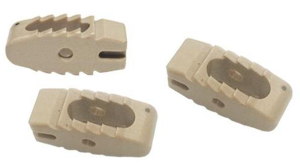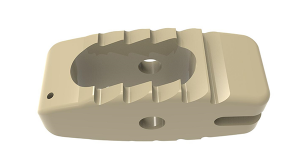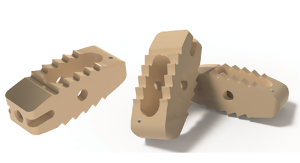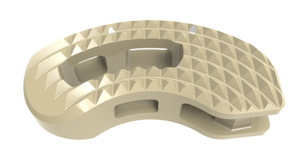PEEKãs excellent material properties lend it to many medical applications, including many implant applications. PEEK is a leading choice in spinal instrumentation, trauma instrumentation, intravascular instrumentation and many other areas of medicine. As medical device manufacturers and various design and engineering companies continue to explore and improve the material, more medical uses for PEEK are on the horizon. Its rapid rise in medicine has made it a major challenger to titanium implants and a leader in many fields.

PEEK has excellent potential in several areas of medicine, including:
1.ô Spinal implantsô ã PEEKãs primary medical application is its use as a spinal implant. The effectiveness and safety of the material in this role have been proved over many years of application and research. Today, PEEK continues to hold an important place in spinal implant surgery, and future developments may make it the most effective option for a wider range of patients.
Patients suffering from degenerative disc disease, degenerative scoliosis, degenerative spondylolisthesis, spinal stenosis or other spine-related disorders can often see significant relief with the use of a spinal cage or spacer.
It is PEEKãs optimal modulus, which closely mimics cortical bone, and radiolucency that makes it a leading choice for spinal implant procedures. Its modulus ensures that the implant bears weight like native bone, reducing the likelihood of nearby bone suffering from subsidence and density loss. Its radiolucent properties ensure that surgeons can monitor patient and implant progress following the procedure. These are basic characteristics that implants must have, and both can be modified to suit specific applications. If surgeons want implants with low radiation transmittance, PEEK can be augmented with a number of additives including Barium Sulfate to provide better contrast.

2.ô Trauma fixationô ã The application of PEEK in trauma fixation has become increasingly important recently. Surgeons looking for alternatives to metal parts have found PEEK an ideal substitute for making bone plates, screws, nails, anchors, and more.
PEEKãs increasing role in trauma fixation is due to the following reasons. First, PEEK bone plates has superior fatigue strength, extending the fatigue life of implanted components compared to metals such as stainless steel. PEEK performs well in trauma fixation, again because of its pure permeability. Surgeons can see exactly how their patientãs respond at the injury site following surgery, allowing them to accurately track and predict the healing process. PEEKãs bone-like modulus also serves patients well when used as a trauma fixation device. With its modulus, PEEK offers an optimal mix of flexibility and stiffness, ensuring it doesnãt get in the way of the bodyãs own healing processes. If needed, PEEK implants can be removed much more easily than metal components, largely due to less bone on-growth with unmodified PEEK.
3.ô Orthopedicô ã PEEK is steadily gaining traction in orthopedics, where it can be utilized in a comprehensive array of procedures. This includes knee and hip arthroplasty, and partial or total replacement applications.
Why is PEEK a perfect fit for orthopedics? For most of the same reasons that it works well in spinal and trauma fixation applications. Proper weight bearing is a primary objective for orthopedic surgical teams, which must preserve as much of the natural function of the joint as possible. PEEK makes this easier to accomplish, as its bone-like modulus ensures it will bear weight and move like bone. Unsurprisingly, radiolucency is also important to orthopedic teams, which must track how the body responds to a partial or total joint replacement. PEEKãs radiolucency allows for extremely accurate image reading.
Another particularly interesting feature of PEEK in orthopedics is its lightweight. PEEK is much lighter than metal, which allows patients to manipulate joints and limbs with less effort than would be necessary with heavier metals. The difference may be subtle, but patients have already reported improved comfort with PEEK components.

4.ô Cardiovascularô ã The cardiovascular field continues to explore PEEK for its purposes, but the polymer already plays an essential role in Less Invasive Ventricular Enhancement, or LIVE, procedures. Until recently, the only reliable way to correct damage to the heart following myocardial infarction was a procedure known as Surgical Ventricular Restoration, or SVR. There are numerous risks associated with SVR, including the risk that comes with having to stop the heart during the procedure. Several incisions are also necessary during SVR, each of which can result in further damage if the surgeon is not extremely precise.
LIVE offers a safer alternative to SVR. During LIVE procedures, a pair of anchors are positioned over the left ventricle, which tends to suffer the most during myocardial infarction. These anchors stabilize the ventricle and ensure it maintains its functionality. The anchors are tied together using a PEEK tether, which keeps the anchors in place, relative to each other. PEEKãs excellent strength as a high-performance polymer is key to LIVE, as a great deal of stress is put on the tether with the heartãs constant beating.

5.ô Dentalô ã PEEKãs use in dentistry is well-established and is most commonly used for removable partial dentures. PEEK works well in this role for many reasons. One of the standout reasons is PEEKãs excellent abrasion and compressive resistance, so it can handle chewing and tearing motions. PEEKãs radiolucency is also essential for dental professionals and provides patients with unmatched comfort and aesthetics. Patients report positive results from PEEK dental implants as they can be easily made to look like natural teeth, donãt affect taste, feel comfortable, and are less prone to allergic reactions or ulcers.

